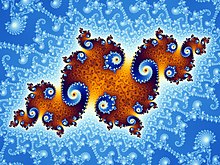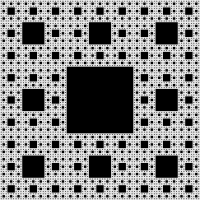
Back Fraktaalmeetkunde Afrikaans Fraktal ALS كسيرة Arabic Fractal AST Fraktal Azerbaijani Фрактал Bashkir Фрактал Byelorussian Фрактал Bulgarian ফ্রাক্টাল Bengali/Bangla Fraktal BS





In mathematics, a fractal is a geometric shape containing detailed structure at arbitrarily small scales, usually having a fractal dimension strictly exceeding the topological dimension. Many fractals appear similar at various scales, as illustrated in successive magnifications of the Mandelbrot set.[1][2][3][4] This exhibition of similar patterns at increasingly smaller scales is called self-similarity, also known as expanding symmetry or unfolding symmetry; if this replication is exactly the same at every scale, as in the Menger sponge, the shape is called affine self-similar.[5] Fractal geometry lies within the mathematical branch of measure theory.
One way that fractals are different from finite geometric figures is how they scale. Doubling the edge lengths of a filled polygon multiplies its area by four, which is two (the ratio of the new to the old side length) raised to the power of two (the conventional dimension of the filled polygon). Likewise, if the radius of a filled sphere is doubled, its volume scales by eight, which is two (the ratio of the new to the old radius) to the power of three (the conventional dimension of the filled sphere). However, if a fractal's one-dimensional lengths are all doubled, the spatial content of the fractal scales by a power that is not necessarily an integer and is in general greater than its conventional dimension.[1] This power is called the fractal dimension of the geometric object, to distinguish it from the conventional dimension (which is formally called the topological dimension).[6]
Analytically, many fractals are nowhere differentiable.[1][4] An infinite fractal curve can be conceived of as winding through space differently from an ordinary line – although it is still topologically 1-dimensional, its fractal dimension indicates that it locally fills space more efficiently than an ordinary line.[1][6]


Starting in the 17th century with notions of recursion, fractals have moved through increasingly rigorous mathematical treatment to the study of continuous but not differentiable functions in the 19th century by the seminal work of Bernard Bolzano, Bernhard Riemann, and Karl Weierstrass,[7] and on to the coining of the word fractal in the 20th century with a subsequent burgeoning of interest in fractals and computer-based modelling in the 20th century.[8][9]
There is some disagreement among mathematicians about how the concept of a fractal should be formally defined. Mandelbrot himself summarized it as "beautiful, damn hard, increasingly useful. That's fractals."[10] More formally, in 1982 Mandelbrot defined fractal as follows: "A fractal is by definition a set for which the Hausdorff–Besicovitch dimension strictly exceeds the topological dimension."[11] Later, seeing this as too restrictive, he simplified and expanded the definition to this: "A fractal is a rough or fragmented geometric shape that can be split into parts, each of which is (at least approximately) a reduced-size copy of the whole."[1] Still later, Mandelbrot proposed "to use fractal without a pedantic definition, to use fractal dimension as a generic term applicable to all the variants".[12]
The consensus among mathematicians is that theoretical fractals are infinitely self-similar iterated and detailed mathematical constructs, of which many examples have been formulated and studied.[1][2][3] Fractals are not limited to geometric patterns, but can also describe processes in time.[5][4][13][14][15][16] Fractal patterns with various degrees of self-similarity have been rendered or studied in visual, physical, and aural media[17] and found in nature,[18][19][20][21] technology,[22][23][24][25] art,[26][27] and architecture.[28] Fractals are of particular relevance in the field of chaos theory because they show up in the geometric depictions of most chaotic processes (typically either as attractors or as boundaries between basins of attraction).[29]
- ^ a b c d e f Mandelbrot, Benoît B. (1983). The fractal geometry of nature. Macmillan. ISBN 978-0-7167-1186-5.
- ^ a b Cite error: The named reference
Falconerwas invoked but never defined (see the help page). - ^ a b Briggs, John (1992). Fractals:The Patterns of Chaos. London: Thames and Hudson. p. 148. ISBN 978-0-500-27693-8.
- ^ a b c Cite error: The named reference
vicsekwas invoked but never defined (see the help page). - ^ a b Cite error: The named reference
Gouyetwas invoked but never defined (see the help page). - ^ a b Mandelbrot, Benoît B. (2004). Fractals and Chaos. Berlin: Springer. p. 38. ISBN 978-0-387-20158-0.
A fractal set is one for which the fractal (Hausdorff-Besicovitch) dimension strictly exceeds the topological dimension
- ^ Segal, S. L. (June 1978). "Riemann's example of a continuous 'nondifferentiable' function continued". The Mathematical Intelligencer. 1 (2): 81–82. doi:10.1007/BF03023065. S2CID 120037858.
- ^ Cite error: The named reference
classicswas invoked but never defined (see the help page). - ^ Cite error: The named reference
MacTutorwas invoked but never defined (see the help page). - ^ Mandelbrot, Benoit (July 8, 2013). "24/7 Lecture on Fractals". 2006 Ig Nobel Awards. Improbable Research. Archived from the original on December 11, 2021.
- ^ Mandelbrot, B. B.: The Fractal Geometry of Nature. W. H. Freeman and Company, New York (1982); p. 15.
- ^ Edgar, Gerald (2007). Measure, Topology, and Fractal Geometry. Springer Science & Business Media. p. 7. ISBN 978-0-387-74749-1.
- ^ Cite error: The named reference
time serieswas invoked but never defined (see the help page). - ^ Krapivsky, P. L.; Ben-Naim, E. (1994). "Multiscaling in Stochastic Fractals". Physics Letters A. 196 (3–4): 168. Bibcode:1994PhLA..196..168K. doi:10.1016/0375-9601(94)91220-3.
- ^ Hassan, M. K.; Rodgers, G. J. (1995). "Models of fragmentation and stochastic fractals". Physics Letters A. 208 (1–2): 95. Bibcode:1995PhLA..208...95H. doi:10.1016/0375-9601(95)00727-k.
- ^ Hassan, M. K.; Pavel, N. I.; Pandit, R. K.; Kurths, J. (2014). "Dyadic Cantor set and its kinetic and stochastic counterpart". Chaos, Solitons & Fractals. 60: 31–39. arXiv:1401.0249. Bibcode:2014CSF....60...31H. doi:10.1016/j.chaos.2013.12.010. S2CID 14494072.
- ^ Brothers, Harlan J. (2007). "Structural Scaling in Bach's Cello Suite No. 3". Fractals. 15 (1): 89–95. doi:10.1142/S0218348X0700337X.
- ^ Cite error: The named reference
heartwas invoked but never defined (see the help page). - ^ Liu, Jing Z.; Zhang, Lu D.; Yue, Guang H. (2003). "Fractal Dimension in Human Cerebellum Measured by Magnetic Resonance Imaging". Biophysical Journal. 85 (6): 4041–4046. Bibcode:2003BpJ....85.4041L. doi:10.1016/S0006-3495(03)74817-6. PMC 1303704. PMID 14645092.
- ^ Karperien, Audrey L.; Jelinek, Herbert F.; Buchan, Alastair M. (2008). "Box-Counting Analysis of Microglia Form in Schizophrenia, Alzheimer's Disease and Affective Disorder". Fractals. 16 (2): 103. doi:10.1142/S0218348X08003880.
- ^ Cite error: The named reference
branchingwas invoked but never defined (see the help page). - ^ Hu, Shougeng; Cheng, Qiuming; Wang, Le; Xie, Shuyun (2012). "Multifractal characterization of urban residential land price in space and time". Applied Geography. 34: 161–170. Bibcode:2012AppGe..34..161H. doi:10.1016/j.apgeog.2011.10.016.
- ^ Karperien, Audrey; Jelinek, Herbert F.; Leandro, Jorge de Jesus Gomes; Soares, João V. B.; Cesar Jr, Roberto M.; Luckie, Alan (2008). "Automated detection of proliferative retinopathy in clinical practice". Clinical Ophthalmology. 2 (1): 109–122. doi:10.2147/OPTH.S1579. PMC 2698675. PMID 19668394.
- ^ Losa, Gabriele A.; Nonnenmacher, Theo F. (2005). Fractals in biology and medicine. Springer. ISBN 978-3-7643-7172-2.
- ^ Cite error: The named reference
seismologywas invoked but never defined (see the help page). - ^ Cite error: The named reference
novelwas invoked but never defined (see the help page). - ^ Cite error: The named reference
African artwas invoked but never defined (see the help page). - ^ Ostwald, Michael J., and Vaughan, Josephine (2016) The Fractal Dimension of Architecture Birhauser, Basel. doi:10.1007/978-3-319-32426-5.
- ^ Baranger, Michael. "Chaos, Complexity, and Entropy: A physics talk for non-physicists" (PDF).